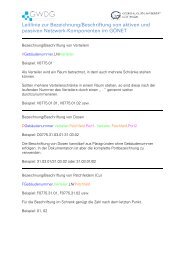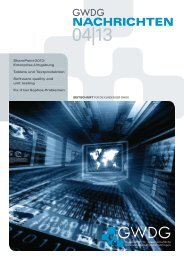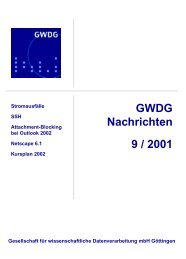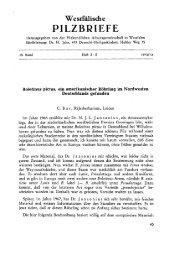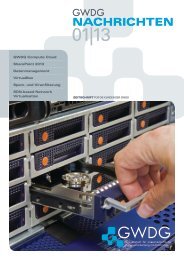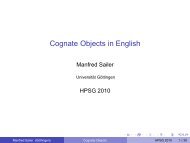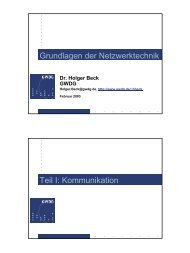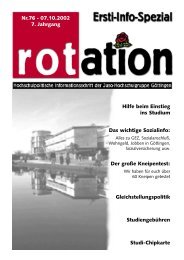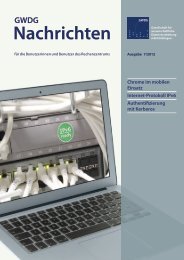Forschung und wissenschaftliches Rechnen - Beiträge zum - GWDG
Forschung und wissenschaftliches Rechnen - Beiträge zum - GWDG
Forschung und wissenschaftliches Rechnen - Beiträge zum - GWDG
Erfolgreiche ePaper selbst erstellen
Machen Sie aus Ihren PDF Publikationen ein blätterbares Flipbook mit unserer einzigartigen Google optimierten e-Paper Software.
object management is abstract, too; this way it is possible to define entirely<br />
new classes of objects and rule bases for them. For instance, simplicial complexes<br />
are objects different from polytopes (which actually includes pointed<br />
unbo<strong>und</strong>ed polyhedra), while tight spans are specializations of polytope objects<br />
since they can be described as the bo<strong>und</strong>ed subcomplexes of certain<br />
unbo<strong>und</strong>ed polyhedra; see Section 5.1.<br />
8 Technical Requirements<br />
polymake can be used on UNIX systems only. It has been successfully<br />
tested on Linux, Sun Solaris, FreeBSD, MacOS X, IBM AIX and Tru64 Unix.<br />
Depending on the size of your objects polymake can run on small machines<br />
with, say, 128 MB of RAM. Only to compile the system from the source code<br />
at least 512MB of RAM is required.<br />
Our website at http://www.math.tu-berlin.de/polymake offers<br />
the full source code as well as several precompiled versions for download.<br />
Acknowledgements<br />
Over the time many people made small and large contributions to the code. Most notably, Thilo<br />
Schröder and Nikolaus Witte are members of the development team since 2002.<br />
Partial f<strong>und</strong>ing for the initial period of 1996–1997 of the polymake project came from the<br />
German-Israeli Fo<strong>und</strong>ation for Scientific Research and Development, grant I-0309-146.06/93 of<br />
Gil Kalai, Peter Kleinschmidt, and Günter M. Ziegler. Later the Deutsche <strong>Forschung</strong>sgemeinschaft<br />
(DFG) partially supported polymake within projects of the Sonderforschungsbereich<br />
288 “Differentialgeometrie <strong>und</strong> Quantenphysik” and the DFG-<strong>Forschung</strong>szentrum Matheon.<br />
References<br />
[1] GeomView, Version 1.8.1, 2002, http://www.geomview.org.<br />
[2] Nina Amenta, Marshall Bern, and David Eppstein, The crust and the beta-skeleton:<br />
combinatorial curve reconstruction, Graphical Models and Image Processing 60 (1998),<br />
no. 2:2, 125–135.<br />
[3] David Avis, lrslib, Version 4.2, 2005, http://cgm.cs.mcgill.ca/~avis/C/<br />
lrs.html.<br />
[4] David Avis, David Bremner, and Raim<strong>und</strong> Seidel, How good are convex hull algorithms?,<br />
Comput. Geom. 7 (1997), no. 5-6, 265–301, 11th ACM Symposium on Computational<br />
Geometry (Vancouver, BC, 1995). MR MR1447243 (98c:52017)<br />
[5] Rouchdi Bahloul and Nobuki Takayama, Local Gröbner fan: polyhedral and computational<br />
approach, 2004, arXiv:math.AG/0412044.<br />
[6] C.B. Barber, D.P. Dobkin, and H.T Huhdanpaa, qhull, Version 2003.1, 2003, http://<br />
www.qhull.org.<br />
[7] Thomas Christof and Andreas Löbel, PORTA - POlyhedron Representation Transformation<br />
Algorithm, Version 1.4.0, 2004, http://www.zib.de/Optimization/<br />
Software/Porta/.<br />
[8] Andreas Dress, Vincent Moulton, and Werner Terhalle, T -theory. An overview, Sém.<br />
Lothar. Combin. 34 (1995), Art. B34b, approx. 23 pp. (electronic). MR 97i:57002<br />
51



